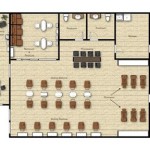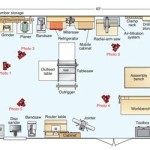An energy efficient home floor plan is a blueprint that prioritizes energy efficiency and sustainability in the design of a home. It incorporates features and strategies aimed at reducing energy consumption and promoting a more environmentally friendly living space. By optimizing the use of natural resources like sunlight and ventilation, these floor plans help homeowners minimize their reliance on artificial energy sources.
For example, an energy efficient home floor plan might include elements such as south-facing windows to maximize passive solar heating, cross-ventilation for natural cooling, and compact, well-insulated building envelopes to reduce heat loss. These features work together to create a home that is comfortable, environmentally friendly, and potentially reduces energy costs.
In this article, we will explore the key principles of energy efficient home floor plans, discuss their benefits, and provide practical tips for incorporating them into your own home design.
Energy efficient home floor plans incorporate a range of strategies to minimize energy consumption and promote sustainability. Here are 8 important points to consider:
- Passive solar design
- Natural ventilation
- Compact building envelope
- High-performance windows
- Energy-efficient appliances
- Renewable energy sources
- Smart home systems
- Sustainable building materials
By incorporating these elements into your home design, you can create a comfortable, environmentally friendly, and cost-effective living space.
Passive solar design
Passive solar design is a building design approach that maximizes the use of natural sunlight to heat a home during the winter and minimize heat gain during the summer. It involves careful consideration of the building’s orientation, window placement, and thermal mass.
To maximize passive solar heating, homes are typically oriented with their south-facing side facing the sun. This allows for maximum sunlight to enter the home through south-facing windows during the winter months, when the sun is lower in the sky. Overhangs or awnings can be used to shade these windows during the summer months, when the sun is higher in the sky and can cause overheating.
In addition to window placement, the thermal mass of a building also plays a role in passive solar design. Thermal mass is the ability of a material to absorb, store, and release heat. Materials with high thermal mass, such as concrete, brick, and tile, can help to regulate the temperature of a home by absorbing heat during the day and releasing it at night.
By carefully considering the orientation, window placement, and thermal mass of a building, passive solar design can help to reduce energy consumption and create a more comfortable and sustainable living environment.
Natural ventilation
Natural ventilation is the process of using outdoor air to cool and ventilate a building. It can be achieved through a variety of means, such as opening windows and doors, using fans, or installing a mechanical ventilation system.
- Cross-ventilation
Cross-ventilation is a technique that involves opening windows and doors on opposite sides of a building to create a flow of air. This can help to cool and ventilate a building, even on hot days.
- Stack ventilation
Stack ventilation is a technique that uses the natural buoyancy of warm air to create a flow of air through a building. Warm air rises, so by opening windows and vents at the top of a building, and lower down near the ground, a flow of air can be created that helps to cool and ventilate the building.
- Wind towers
Wind towers are vertical structures that are used to capture and direct wind into a building. They can be used to cool and ventilate a building, even on days when there is little to no wind.
- Passive downdraught evaporative cooling
Passive downdraught evaporative cooling (PDE) is a technique that uses the evaporation of water to cool a building. Water is trickled down a porous material, such as a mat or fabric, and as the water evaporates, it cools the air. The cooled air then falls down through the building, helping to cool it.
Natural ventilation can be a very effective way to cool and ventilate a building, and it can also help to reduce energy consumption. By using natural ventilation techniques, you can create a more comfortable and sustainable indoor environment.
Compact building envelope
A compact building envelope is a design strategy that aims to minimize the surface area of a building’s exterior walls and roof. This can be achieved by using a simple, rectangular building shape, avoiding complex rooflines, and minimizing the number of windows and doors.
Reducing the surface area of the building envelope helps to reduce heat loss and gain, which can lead to significant energy savings. A smaller surface area means that there is less opportunity for heat to escape from the building during the winter, and less opportunity for heat to enter the building during the summer.
In addition to energy savings, a compact building envelope can also lead to other benefits, such as reduced construction costs and improved structural integrity. Buildings with a smaller surface area require less materials to build, and they are less likely to be damaged by high winds or other extreme weather events.
When designing a home with a compact building envelope, it is important to consider the following factors:
- Shape: The most compact building shape is a cube, but this is not always practical for residential design. However, by using a simple, rectangular shape, you can minimize the surface area of the building envelope.
- Roofline: Complex rooflines, such as those with multiple gables or dormers, can increase the surface area of the building envelope. By using a simple roofline, you can reduce heat loss and gain.
- Windows and doors: Windows and doors are necessary for natural light and ventilation, but they can also be a source of heat loss and gain. By minimizing the number of windows and doors, and by using energy-efficient windows and doors, you can reduce the impact on your home’s energy consumption.
By following these tips, you can design a home with a compact building envelope that is energy-efficient, cost-effective, and structurally sound.
High-performance windows
High-performance windows are an important component of an energy-efficient home floor plan. They are designed to minimize heat loss and gain, while still allowing for natural light and ventilation. High-performance windows typically have the following features:
- Low-E coating: A low-E coating is a thin, transparent coating that is applied to the glass of a window. It helps to reflect heat back into the home during the winter, and to reflect heat away from the home during the summer.
- Multiple panes: High-performance windows typically have two or more panes of glass, with a vacuum or gas-filled space between the panes. This helps to reduce heat transfer between the inside and outside of the home.
- Tight seals: High-performance windows are tightly sealed to prevent air leakage. This helps to reduce heat loss and gain, and can also improve the soundproofing of the home.
When choosing high-performance windows, it is important to consider the following factors:
- Climate: The climate in which you live will affect the type of high-performance windows that you need. For example, if you live in a cold climate, you will need windows with a low-E coating and multiple panes to minimize heat loss. If you live in a warm climate, you may need windows with a solar control coating to reduce heat gain.
- Orientation: The orientation of your home will also affect the type of high-performance windows that you need. For example, if you have a south-facing home, you may need windows with a solar control coating to reduce heat gain. If you have a north-facing home, you may need windows with a low-E coating to maximize heat gain.
- Budget: High-performance windows can be more expensive than standard windows. However, the energy savings that you can achieve over the life of the windows can often offset the initial cost.
By choosing the right high-performance windows for your home, you can significantly reduce your energy consumption and create a more comfortable and sustainable living environment.
In addition to the features listed above, high-performance windows may also have other features, such as:
- Impact resistance: Impact-resistant windows are designed to withstand high winds and other impacts. This can be important for homes in areas that are prone to hurricanes or other severe weather events.
- Soundproofing: Soundproof windows are designed to reduce noise pollution from outside. This can be important for homes that are located near busy roads or other sources of noise.
- Decorative features: High-performance windows are available in a variety of styles and finishes, so you can choose windows that complement the architectural style of your home.
By considering all of these factors, you can choose the right high-performance windows for your home and enjoy the benefits of energy efficiency, comfort, and durability.
Energy-efficient appliances
Energy-efficient appliances are an important part of an energy-efficient home floor plan. They are designed to use less energy than standard appliances, which can save you money on your utility bills and help to reduce your environmental impact.
- Refrigerators
Refrigerators are one of the most energy-intensive appliances in the home. When choosing a new refrigerator, look for models with the ENERGY STAR label. ENERGY STAR refrigerators meet strict energy efficiency standards set by the U.S. Environmental Protection Agency (EPA).
- Dishwashers
Dishwashers are another major energy user in the home. ENERGY STAR dishwashers use less energy and water than standard dishwashers. They also have features that can help you save even more energy, such as a soil sensor that adjusts the wash cycle based on the dirtiness of the dishes.
- Washing machines
Washing machines are another important appliance to consider when making your home more energy-efficient. ENERGY STAR washing machines use less energy and water than standard washing machines. They also have features that can help you save even more energy, such as a cold water wash cycle and a high-efficiency spin cycle.
- Clothes dryers
Clothes dryers are one of the most energy-intensive appliances in the home. When choosing a new clothes dryer, look for models with the ENERGY STAR label. ENERGY STAR clothes dryers use less energy than standard clothes dryers. They also have features that can help you save even more energy, such as a moisture sensor that automatically turns off the dryer when the clothes are dry.
By choosing energy-efficient appliances, you can save money on your utility bills and help to reduce your environmental impact. When shopping for new appliances, look for the ENERGY STAR label to ensure that you are choosing the most energy-efficient models available.
Renewable energy sources
Renewable energy sources can play a major role in reducing the energy consumption of a home. By incorporating renewable energy sources into your home’s floor plan, you can generate your own clean, renewable energy and reduce your reliance on fossil fuels.
- Solar energy
Solar energy is the most abundant source of energy on Earth. Solar panels can be installed on the roof of your home to convert sunlight into electricity. Solar energy is a clean, renewable source of energy that can help you reduce your energy bills and your environmental impact.
- Wind energy
Wind energy is another renewable source of energy that can be used to power your home. Wind turbines can be installed on your property to convert the kinetic energy of the wind into electricity. Wind energy is a clean, renewable source of energy that can help you reduce your energy bills and your environmental impact.
- Geothermal energy
Geothermal energy is the heat from the Earth’s core. Geothermal heat pumps can be installed in your home to use this heat to warm your home in the winter and cool your home in the summer. Geothermal energy is a clean, renewable source of energy that can help you reduce your energy bills and your environmental impact.
- Hydroelectric energy
Hydroelectric energy is the energy of flowing water. Hydroelectric dams can be built to generate electricity from the flow of water. Hydroelectric energy is a clean, renewable source of energy that can help you reduce your energy bills and your environmental impact.
By incorporating renewable energy sources into your home’s floor plan, you can create a more sustainable and energy-efficient home. Renewable energy sources can help you reduce your energy bills, your reliance on fossil fuels, and your environmental impact.
Smart home systems
Smart home systems are an important part of an energy-efficient home floor plan. They can help you to automate your home’s energy consumption, making it more efficient and saving you money on your utility bills.
One of the most important ways that smart home systems can help you to save energy is by automating your home’s heating and cooling system. Smart thermostats can be programmed to learn your heating and cooling preferences and adjust the temperature accordingly. This can help to prevent your home from getting too hot or too cold, which can waste energy.
Smart home systems can also help you to save energy by automating your home’s lighting. Smart light bulbs can be programmed to turn on and off automatically, or to dim or brighten based on the time of day or the amount of natural light available. This can help to prevent you from leaving lights on when you don’t need them, which can waste energy.
In addition to automating your home’s energy consumption, smart home systems can also help you to monitor your energy usage. This can help you to identify areas where you can save energy, and make changes to your habits accordingly. Many smart home systems allow you to track your energy usage in real time, so you can see how your actions are affecting your energy consumption.
Smart home systems are a valuable tool for homeowners who want to save energy and live a more sustainable lifestyle. By automating your home’s energy consumption and monitoring your energy usage, smart home systems can help you to reduce your energy bills and your environmental impact.
Sustainable building materials
Sustainable building materials are an important part of an energy-efficient home floor plan. They are produced in a way that minimizes their environmental impact, and they can help to improve the energy efficiency of your home.
- Recycled materials
Recycled materials, such as recycled steel, aluminum, and glass, can be used to create a variety of building materials, including framing, siding, and roofing. Using recycled materials helps to reduce the demand for new materials, which can help to conserve natural resources and reduce pollution.
- Renewable materials
Renewable materials, such as bamboo, cork, and linoleum, are made from plants that can be grown and harvested without depleting natural resources. Renewable materials are a sustainable choice for building materials because they can be replenished naturally.
- Low-VOC materials
Low-VOC (volatile organic compound) materials emit few or no harmful chemicals into the air. This is important for indoor air quality, as VOCs can contribute to health problems such as asthma and allergies. Low-VOC materials include paints, finishes, and adhesives.
- Energy-efficient materials
Energy-efficient materials, such as insulated concrete forms (ICFs) and radiant floor heating systems, can help to reduce the energy consumption of your home. ICFs are blocks made of polystyrene foam that are filled with concrete. They provide excellent insulation, which can help to reduce heat loss in the winter and heat gain in the summer. Radiant floor heating systems use warm water to heat the floor, which provides a more comfortable and energy-efficient way to heat your home.
By using sustainable building materials in your home, you can help to reduce your environmental impact and create a more energy-efficient and healthy home.










Related Posts








